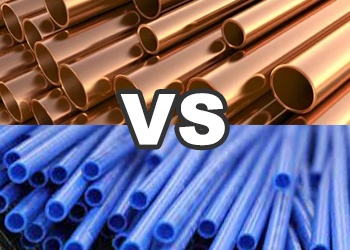 PEX (Cross-linked Polyethylene) and copper are two common materials used for plumbing systems, particularly in residential and commercial buildings. Both materials have their own advantages and disadvantages, and the choice between PEX and copper often depends on factors such as cost, ease of installation, longevity, and local building codes. Here’s a comparison of PEX and copper:
PEX (Cross-linked Polyethylene) and copper are two common materials used for plumbing systems, particularly in residential and commercial buildings. Both materials have their own advantages and disadvantages, and the choice between PEX and copper often depends on factors such as cost, ease of installation, longevity, and local building codes. Here’s a comparison of PEX and copper:
PEX (Cross-linked Polyethylene)
Advantages:
- Cost-Effective: PEX is generally less expensive than copper, both in terms of material cost and installation. PEX pipes are often cheaper per linear foot than copper pipes.
- Flexible: PEX is highly flexible, which makes it easier to install in tight spaces, around corners, and through walls. This flexibility can reduce the need for fittings and connectors, minimizing potential leak points.
- Corrosion Resistance: PEX pipes do not corrode or develop mineral deposits over time, unlike copper pipes, which can be susceptible to corrosion in certain water conditions.
- Freeze Resistance: PEX has some resistance to freezing, as it can expand and contract without bursting under certain conditions. However, it’s still important to take precautions in extremely cold environments.
- Noise Reduction: PEX tends to be quieter than copper pipes, as it dampens water hammer and other noises associated with water flow.
Disadvantages:
- UV Sensitivity: PEX can be sensitive to ultraviolet (UV) light and should not be exposed to direct sunlight for prolonged periods.
- Temperature Limitations: PEX may not be suitable for very high-temperature applications, such as some industrial processes.
- Chemical Sensitivity: PEX can react with certain chemicals, potentially leading to degradation over time.
COPPER
Advantages:
- Longevity: Copper pipes are known for their long lifespan. Properly installed and maintained copper pipes can last for decades.
- Heat Resistance: Copper can handle high temperatures and is commonly used for hot water distribution.
- Proven Track Record: Copper plumbing systems have been used for many years, and their performance is well understood.
- Resistance to Chemicals: Copper pipes are generally resistant to chemicals found in water and household plumbing systems.
Disadvantages:
- Cost: Copper pipes are more expensive than PEX pipes, both in terms of material cost and installation.
- Corrosion: In certain water conditions, copper pipes can corrode over time, leading to pinhole leaks.
- Labor-Intensive Installation: Copper pipes require soldering at joints, which can be more labor-intensive compared to the crimping or clamping methods used with PEX.
- Rigid: Copper pipes are less flexible than PEX pipes, making them more challenging to install in tight or complex spaces.
In summary, both PEX and copper have their own strengths and weaknesses. The choice between the two depends on factors such as budget, local building codes, the intended use of the plumbing system, and personal preferences. It’s a good idea to consult with a plumbing professional to determine the best material for your specific needs.
